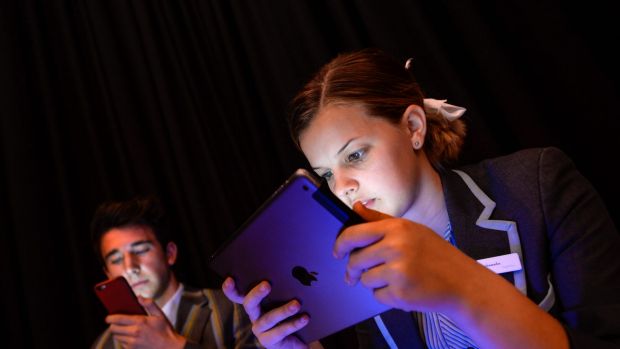
Teenagers spending too much time on electronic devices is raising concerns about inactivity and obesity. Sienna Withington and Daniel Marks using their devices. Photo: Justin McManus
Teenagers are spending more time on electronic devices including phones, tablets and laptops, raising concerns about low levels of physical activity and links to obesity.
A study of 9000 secondary school students by the Cancer Council and National Heart Foundation found 77 per cent of students were spending more than two hours a day using electronic media for entertainment in 2012-13, up from 71 per cent of students three years earlier.
The time spent using devices to engage with social media, play video games or watch television was on top of time spent using them in the classroom or to complete homework.
Increasing screen time came as teenagers reported low levels of physical activity, with just 18 per cent of students achieving the recommended 60 minutes or more of exercise each day.
Only 11 per cent of girls were physically active for at least 60 minutes a day, compared to 24 per cent of boys.
Cancer Council public health committee chairman Craig Sinclair said the figures were concerning given evidence linking increased time on electronic devices with decreased physical activity.
“It makes sense because you are literally running out of time to be physically active,” he said.
“This is a real concern when we combine that with the potential for unhealthy diets.
“We know that teenagers who do become overweight have significant trouble reducing their weight as they go into adult life, and there is a strong correlation between being overweight or obese and a range of chronic diseases.”
The study collected data from students in years 8 to 11 at 196 schools around Australia.
It found 23 per cent of students were overweight or obese, in a finding that remained steady from three years earlier.
Bucking the trend toward more screen time is Albert Park College student Sienna Withington, 15, a taekwondo black belt whose three hours of training each night leaves little time for social media.
Combined with hours of homework, Sienna said she was the odd one out among her friends.
“I’m definitely the one who’s not on social media or Facebook much. It’s kind of different when they are all using it and I’m like, ‘yeah, I’ve just been doing homework’. They usually keep me up to date anyway when I see them in person,” she said.
Fellow college student Daniel Marks, 18, also divides most of his time outside school between homework and his chosen sport of basketball.
He said he noticed many of the younger students spent lunch breaks playing on their iPad , meaning they did not do any physical activity during the day.
College principal Steven Cook said technology was integral to the lives of his students but it was important to get the balance right, with the school also running a basketball academy and offering activities including lifesaving, sailing and beach volleyball.
“As a parent myself I have to guide my kids through the use of technology. In my era it was all about the introduction of TV, now it’s social media, but the challenges in my view are very similar.”
